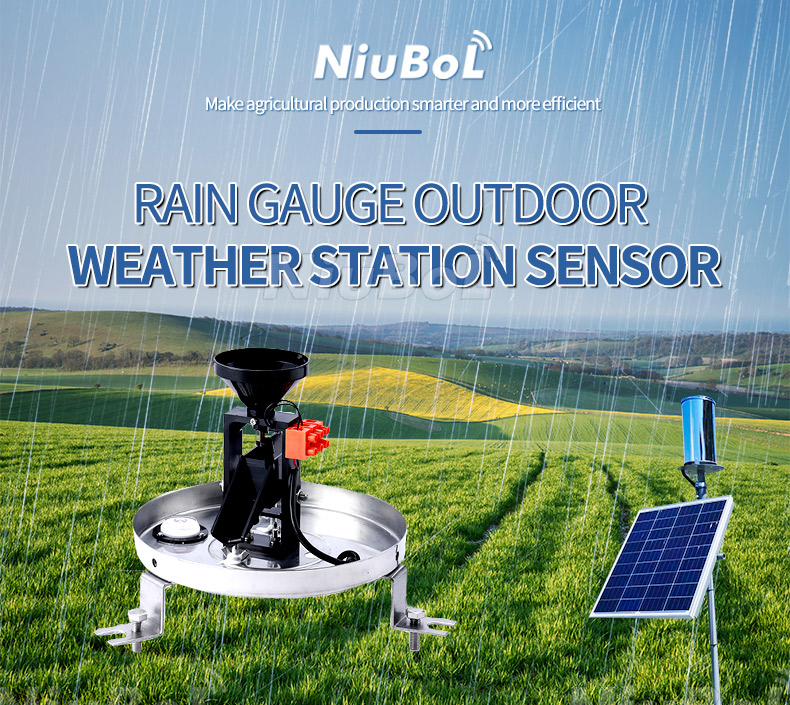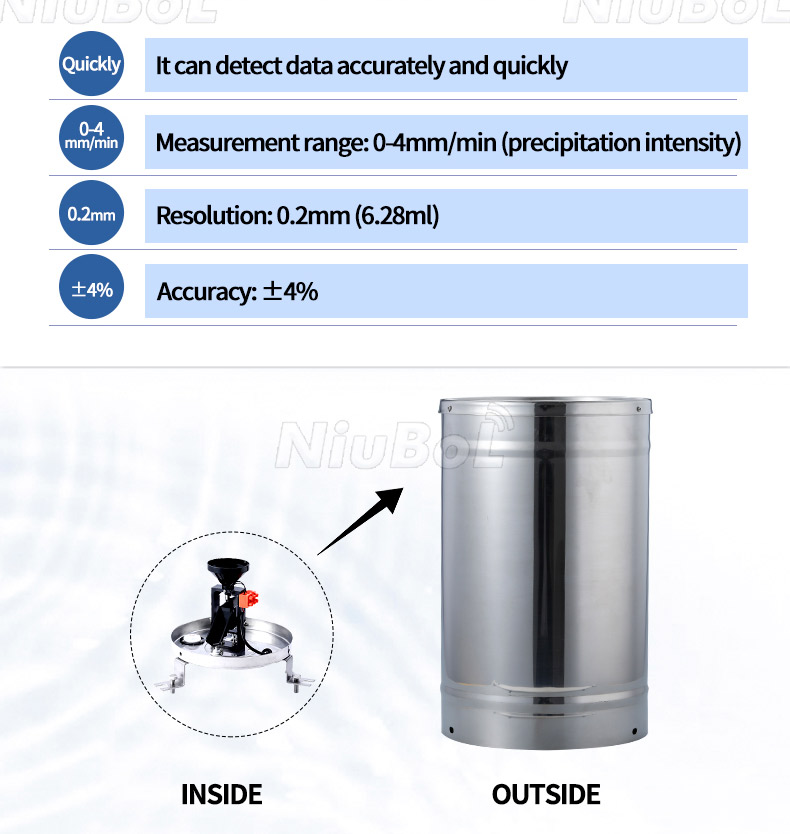

— Blogs —
—Products—
 Consumer hotline +8618073152920
Consumer hotline +8618073152920 WhatsApp:+8615367865107
Address:Room 102, District D, Houhu Industrial Park, Yuelu District, Changsha City, Hunan Province, China
Product knowledge
Time:2024-06-16 21:20:46 Popularity:345
Intelligent agricultural weather station is a kind of meteorological monitoring equipment applied in the field of agricultural production, which can collect and record meteorological data in the farmland environment in real time, such as temperature, humidity, light, wind speed, precipitation and so on. The collection and analysis of these data is of great significance to agricultural production, which can help farmers better understand the changes in the farmland environment and carry out scientific management.
Intelligent agro-weather stations are generally composed of sensors, data acquisition modules, data transmission modules and user interfaces. The sensors are used to monitor various meteorological factors in the farmland environment, the data acquisition module is responsible for processing and storing the sensor data, and the data transmission module transmits the collected data to the user interface, through which the user can view and analyze the data and adjust the agricultural production strategy according to the data.
The Agricultural Greenhouse Weather Station can monitor a wide range of environmental factors to ensure that crops grow under optimal growing conditions. The following are some common monitoring parameters:
1. Temperature: Through temperature sensors, the temperature changes in the greenhouse are monitored in real time to ensure that the crops grow within the appropriate temperature range. If the temperature is too low, the growth of the crop will slow down and the yield will decrease; if the temperature is too high, the crop will have physiological wilting or even die. The accuracy of the temperature sensor can reach ± 0.3 ℃, the range of -30 ~ 70 ℃.
2. Humidity: The humidity sensor can measure the relative humidity inside the greenhouse to help farmers understand the changes in humidity inside the greenhouse, so as to carry out reasonable humidity control. Too high humidity will lead to water vapor condensation inside the greenhouse, increasing the possibility of pests and diseases; too low humidity will lead to crop dryness and water shortage, affecting growth.NiuBoL humidity sensor's measurement range is 0 to 100%, with an accuracy of ±3%.
Temperature and humidity in the greenhouse are important factors affecting crop growth. The suitable temperature range in the greenhouse is usually 18℃-28℃, and the humidity range is 60%-80%.
3. Light intensity: light intensity sensor can measure the light intensity in the greenhouse, providing farmers with light management basis. The light intensity sensor can measure the light intensity in the greenhouse to provide farmers with a basis for light management, to ensure that the crop gets enough light for photosynthesis. Light intensity sensor measurement range of 0 ~ 200000lux, accuracy of ± 5%.
4. Carbon dioxide concentration: carbon dioxide concentration sensor can real-time monitoring of carbon dioxide concentration in the greenhouse, because carbon dioxide is an important raw material for crop photosynthesis. Provide a suitable environment for crop growth.
5. Soil temperature: soil temperature sensor can monitor the soil temperature changes, which is very important for understanding the growth environment of crop roots.
6. Soil Moisture: Soil moisture sensors can measure the moisture content of the soil to help farmers determine the timing and amount of irrigation to avoid the effects of too much or too little water on crop growth.
7. Wind speed and direction: Wind speed and direction sensors can monitor the wind speed and direction outside the greenhouse, providing farmers with information on weather changes and helping to prevent wind damage and other unfavorable weather conditions from affecting crops.
8. Atmospheric pressure: Atmospheric pressure sensors can monitor changes in atmospheric pressure, which is helpful in predicting weather changes and the stability of the growing environment for crops.
9. Rainfall: Rainfall sensors can measure the rainfall outside the greenhouse, providing farmers with rainfall information that can help rationalize irrigation and drainage efforts.


These monitoring parameters can help farmers better understand the environmental conditions inside the greenhouse and take timely management measures to improve crop yield and quality. Different agricultural greenhouse weather stations may have different monitoring parameters and functions, and farmers can choose the appropriate equipment according to their needs.
The functions of agricultural greenhouse weather station mainly include:
1. Real-time monitoring: real-time monitoring of various meteorological parameters in the greenhouse through sensors to ensure the accuracy and real-time data.
2. Data recording and storage: automatically record and store the monitored data for subsequent viewing and analysis.
3. Remote control: Support remote viewing of meteorological data in the greenhouse through cell phones or computers and other terminal devices, and carry out control operations such as irrigation, ventilation, heating, etc. as needed.
4. Data analysis and processing: process and analyze the collected data, generate various weather charts and reports, and provide farmers with intuitive data display and analysis results.
5. Early warning function: According to the set threshold, when a meteorological parameter exceeds the normal range, it will send out early warning information to remind farmers to take timely measures.
6. Data transmission: support wireless communication, the data can be uploaded to your own designated computer or to the total server, which is convenient for data sharing and management.
Smart agricultural weather station has the following advantages:
1. real-time monitoring: it can understand the meteorological changes in farmland in real time and provide timely information reference for farmers.
2. scientific management: through the analysis of meteorological data, it helps farmers scientifically adjust agricultural production measures to improve yield and quality.
3. energy saving and emission reduction: intelligent agricultural weather station helps to reduce the excessive use of chemical fertilizers and pesticides, and reduce the pollution of agricultural production on the environment.
4. Convenient and efficient: through wireless transmission and cloud storage, it is convenient for farmers to view and manage farm weather data at any time.
In short, the agricultural greenhouse weather station is a powerful monitoring device that can be selected and configured according to specific needs. In the future, with the development of the Internet of Things, big data and other technologies, the intelligent agricultural weather station will become more popular, providing more refined and intelligent services for agricultural production, providing accurate data support for farmers, helping them to better manage their farmland and improve crop yield and quality.
Prev:Smart Agricultural Weather Station Maintenance and Management
Next:Importance and functions of forest weather stations and forest fire weather stations
Related recommendations
Sensors & Weather Stations Catalog
Agriculture Sensors and Weather Stations Catalog-NiuBoL.pdf
Weather Stations Catalog-NiuBoL.pdf
Related products
 Combined air temperature and relative humidity sensor
Combined air temperature and relative humidity sensor Soil Moisture Temperature sensor for irrigation
Soil Moisture Temperature sensor for irrigation Soil pH sensor RS485 soil Testing instrument soil ph meter for agriculture
Soil pH sensor RS485 soil Testing instrument soil ph meter for agriculture Wind Speed sensor Output Modbus/RS485/Analog/0-5V/4-20mA
Wind Speed sensor Output Modbus/RS485/Analog/0-5V/4-20mA Tipping bucket rain gauge for weather monitoring auto rainfall sensor RS485/Outdoor/stainless steel
Tipping bucket rain gauge for weather monitoring auto rainfall sensor RS485/Outdoor/stainless steel Pyranometer Solar Radiation Sensor 4-20mA/RS485
Pyranometer Solar Radiation Sensor 4-20mA/RS485
Screenshot, WhatsApp to identify the QR code
WhatsApp number:+8615367865107
(Click on WhatsApp to copy and add friends)